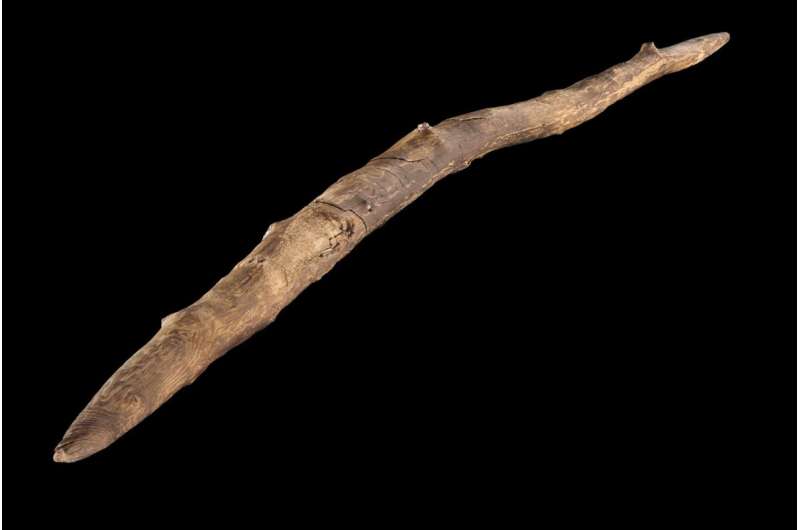This article has been reviewed according to Science X's editorial process and policies. Editors have highlighted the following attributes while ensuring the content's credibility:
fact-checked
peer-reviewed publication
trusted source
proofread
Early humans were weapon woodwork experts, study finds

A 300,000-year-old hunting weapon has shone a new light on early humans as woodworking masters, according to a new study.
State-of-the-art analysis of a double-pointed wooden throwing stick, found in Schöningen in Germany three decades ago, shows it was scraped, seasoned and sanded before being used to kill animals. The research indicates early humans' woodworking techniques were more developed and sophisticated than previously understood.
The findings, published today in PLOS ONE, also suggest the creation of lightweight weapons may have enabled group hunts of medium and small animals. The use of throwing sticks as hunting aids could have involved the entire community, including children.
Dr. Annemieke Milks, of the University of Reading's Department of Archaeology, led the research. She said, "Discoveries of wooden tools have revolutionized our understanding of early human behaviors. Amazingly these early humans demonstrated an ability to plan well in advance, a strong knowledge of the properties of wood, and many sophisticated woodworking skills that we still use today."
"These lightweight throwing sticks may have been easier to launch than heavier spears, indicating the potential for the whole community to take part. Such tools could have been used by children while learning to throw and hunt."
Co-author Dirk Leder said, "The Schöningen humans used a spruce branch to make this aerodynamic and ergonomic tool. The woodworking involved multiple steps including cutting and stripping off the bark, carving it into an aerodynamic shape, scraping away more of the surface, seasoning the wood to avoid cracking and warping, and sanding it for easier handling."

High-impact weapon
Found in 1994, the 77cm-long stick is one of several different tools discovered in Schöningen, which includes throwing spears, thrusting spears and a second similarly sized throwing stick.
The double-pointed throwing stick—analyzed to an exceptionally high level of detail for this new study—was most likely used by early humans to hunt medium-sized game like red and roe deer, and possibly fast-small prey including hare and birds that were otherwise difficult to catch.
The throwing sticks would have been thrown rotationally—similar to a boomerang—rather than overhead like a modern-day javelin and may have enabled early humans to throw as far as 30 meters. Although lightweight, the high velocities at which such weapons can be launched could have resulted in deadly high-energy impacts.
The fine surface, carefully shaped points and polish from handling suggest this was a piece of personal kit with repeated use, rather than a quickly made tool that was carelessly discarded.
Principal investigator Thomas Terberger said, "The systematic analysis of the wooden finds of the Schöningen site financed by German Research Foundation provides valuable new insights and further exciting information on these early wooden weapons can be expected soon."
The well-preserved stick is on display at the Forschungsmuseum in Schöningen.
More information: A double-pointed wooden throwing stick from Schöningen, Germany: Results and new insights from a multianalytical study, PLoS ONE (2023). DOI: 10.1371/journal.pone.0287719
Journal information: PLoS ONE
Provided by University of Reading


















